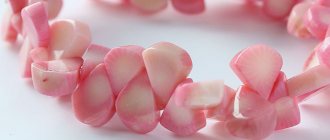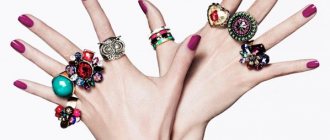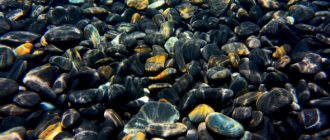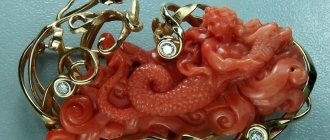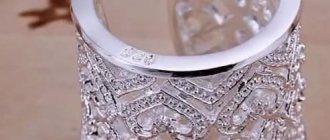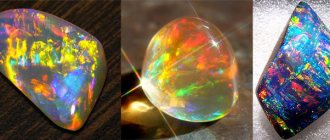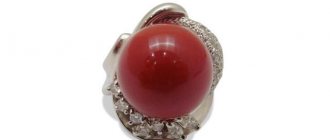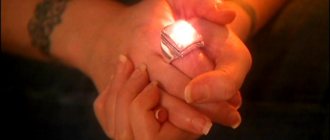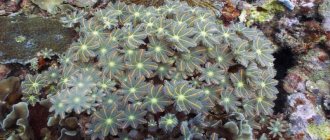- Which: Semi-precious;
- Deposits: Red and Mediterranean seas, coasts of Thailand, Japan, Algeria, Malaysia, India, Australia;
- Colors: Red, Black, Pink, White, Blue;
- Mohs hardness: 3.75;
- Transparency: Opaque;
- Density: 2.6-2.7 g/cm³;
- Formula: Ca(CO)3;
- Suitable person according to zodiac sign: Everyone;
- How much does it cost: from 20 rubles. (per bead).
Coral is a semi-precious stone of organic origin. It is formed by the oldest groups of multicellular organisms - coral polyps, which have been on earth for about 550 million years.
It is perhaps the first mineral used to create jewelry. The oldest products with coral inserts found by archaeologists date back to the 4th century BC.
Currently, the level of pollution in the world's oceans threatens the existence of this amazing mineral, so its value is steadily growing every year.
Origin story
The name of the stone has several versions. According to one of them, the Greek word “coralion” means “that which was hard in the hand.” Coral was popular back in Mesopotamia and Ancient Egypt, but it earned special respect during antiquity.
It often figured in ancient Greek mythology, and the supreme sea god Poseidon lived in a palace built from these stones.
According to another version, the Arabic word “goral” means “amulet stone”. Muslims used black corals to create mourning wreaths, rosaries, knife handles, and cane handles. It was believed that the powerful spiritual powers of the stone were transferred to its owner.
In Rus' there was a widespread belief that coral was found in the brain of a dragon, so it was called dragonite. It was considered a prophetic stone and was used to perform magical rituals. Ominous properties were attributed to draconite; he was an instrument of revenge and damage.
In the Middle Ages, Venice became the center of trade in these stones. Red corals were used to make body jewelry, miniature sculptures, and inlaid weapons and church book covers with them. The pink stone was worn by young girls as a symbol of modesty and purity.
These days, most corals come to the world market from India, Japan, Hong Kong and Taiwan. The unusual stone is still of interest not only to collectors, but is also experiencing a new wave of popularity.
Origin and extraction
Coral polyp
By processing salts contained in seawater, coral polyps secrete lime to form plantar plates. As a result, coral reefs, atolls and even entire islands appear.
For a long time, corals were considered plants, and only in the 18th century their animal origin was proven.
In jewelry, only lime frames are used - external skeletons left after the death of polyps. The most valuable part is the top of the coral tree.
On an industrial scale, corals are harvested using weighted, coarse nets that are moved and dragged along the seabed. Management of bottom nets and trawls is automated. However, with such mining, most of the valuable material deteriorates and perishes.
The profession of coral diver is still in demand. Many of them die at an early age, faced with the dangers that hide the underwater depths; others due to caisson disease.
The best fishermen live on the island of Cozumel, located in the Caribbean Sea off the coast of Mexico.
Decorations
Features and properties of coral beads
Coral is an amazing mineral that forms at the bottom of the warm waters of seas and oceans. It is essentially the hardened skeleton of coral polyps and is highly prized in the jewelry industry. A variety of jewelry is created from it: earrings, rings, bracelets, rosaries and, of course, beads.
Corals can be colored in a variety of shades: red, pink, white, milky, blue, black, purple, lilac. In addition to its impressive appearance, the mineral is filled with special energetic power, which manifests itself in magical and healing properties. Coral is a symbol of youth, health, family happiness, longevity, love, trust and kindness. In addition, it is able to improve the functioning of many organs, normalize the condition of the entire body, fill the owner with vitality, strengthen tone, calm the nervous system, relieve insomnia and nightmares.
Coral beads have never gone out of style. However, it is worth noting that in different periods, certain shades of the mineral may have lost their relevance, but not the product itself. It is made in a variety of designs, shapes, sizes and all decorations differ from each other in individuality and uniqueness.
Physicochemical characteristics
Coral is an opaque stone that is translucent around the edges. The hardness of the mineral is low: for red varieties it is 3-4 according to Mohs, for black varieties it is two times lower. As a result, the coral is easily scratched by a knife.
In its raw form, the stone has a matte, even rough surface. It is rubbed with special wax polishes, giving it a silky shine.
When worn, natural corals may fade and turn pale. But the most common reason for this phenomenon is poor-quality painting.
Cheap white and even pink corals are dipped in hydrogen peroxide to impart the popular red hue, and are also treated with chemical dyes.
What is white coral
White coral is a mineral formed naturally through the fossilization of living polyps. The process is slow - the growth is 1 cm per year. Over thousands of years, coral reefs and even islands are formed, formed by the accumulation of many calcareous skeletons.
Externally, white coral is opaque, has a matte shine, and is used for jewelry in its natural form (looks like a fluffy bush) or in the form of beads, geometric shapes, and figurines.
The main place of production is the Sea of Japan.
The stone left its mark on the history of mankind:
- In Ancient Greece and Rome it was worn against the evil eye and damage;
- for Indians it was a symbol of enlightenment, holiness, and was worth on a par with pearls;
- medieval Europeans identified it with modesty;
- in many countries, especially those with access to the sea, it was a talisman for travelers.
To watch a video on the topic:
Colors
Natural coral has a rich color palette - 350 shades. The color of the mineral depends on the level of light during its growth, as well as the composition of the organic matter.
The most popular types in jewelry are:
Red and pink corals
They owe their color to their high iron content. They are found mainly in warm seas at depths from 30 to 500 meters. The best red corals are found off the coast of Algeria.
Blacks, or Akkabars
They do not like sunlight and grow in caves and grottoes at great depths in the waters near Mexico and Australia. The resulting stones have low hardness, so only stones over 50 years old are used in jewelry.
White, or bianco
These corals are considered the cheapest, so they are often painted in more popular colors.
Blue, or Akori
They are highly porous and difficult to polish. The rarest and most valuable are spongy akori of a rich, almost blue color.
Pale pink corals
Received the name “angel skin”. These delicate natural stones are also highly valued.
In addition, multi-colored corals are often found in nature - a fantastic combination of gold, black and red hues.
Medicinal properties
There is an unconventional medical practice that uses the healing properties of precious and ornamental jewelry stones - lithotherapy.
According to this theory, coral is capable of:
- Activate metabolism.
- Normalize the functioning of the cardiovascular system.
- Help with depression and neuroses.
- Heal abscesses and ulcers, including internal ones.
- Regulate the functioning of the pancreas.
In addition, the stone is a source of protoglandin hormones. It is ground into dust and taken internally as a contraceptive.
Hindus believe that coral affects the throat chakra, which is responsible for breathing, hearing and skin. Ayurveda includes coral among the nine stones that symbolize the planets and control all processes on earth.
Blood red stone is associated with Mars, the patron of vital energy and passion.
It warms its owner and inspires him to take courageous and courageous actions.
In Portugal they believe that red coral helps with headaches, in England - with sore throat, in Mexico - with fever. In Southeast Asian countries, coral powder is sold in pharmacies and added to ointments, tinctures, and mixtures.
White coral is used in Japan for dental prosthetics to speed up the healing of bone fractures. Its calcium structure is easily perceived and absorbed by the human body.
Coral is also popular in cosmetology. It is based on antioxidant peeling, which has an effective rejuvenating effect on the skin.
Magical properties and beliefs
As a talisman, coral improves memory. It is considered a talisman against poison, witchcraft, shortness of breath, loss of appetite, and develops intuition and logic.
The ideal time to wear it is the new moon phase, and the most dangerous time is the full moon period. It is not recommended to wear coral jewelry often, as it provokes capriciousness and eccentricity.
Natural stone has long been considered the patron saint of travelers.
It protects against dangers that lurk on long journeys, helps to establish new connections, calms bad weather, calms storms and thunderstorms.
However, a coral sunset in the evening sky foreshadows windy and turbulent weather.
Phallic-shaped coral amulets are very popular in Thailand.
They symbolize the linga of the god Shiva, which protects the owner from evil spirits. Amulets are worn around the neck or on the belt, mantras are read over them, and ritual chants are performed.
In South India, Kyrgyzstan and Tajikistan, women wear coral beads to bring peace and harmony to their marriages and to cope with infertility.
In addition, the mineral acts as an indicator of health status - a sharp loss of color indicates a serious illness of its owner. If you dreamed of coral, this is a sign of recovery from a serious illness.
35 years of married life together is called a coral wedding. On this anniversary, husband and wife give each other jewelry with coral inserts, talismans and souvenirs.
Cost of coral jewelry
Most often, this mineral is framed in silver or gold. Silver earrings with coral inserts can be purchased at a jewelry store for about 2000-3000 rubles, but the stone will be red, not pink, since items with a lighter shade are much more difficult to find.
Coral bracelets with silver inserts costing from 1,500 rubles and more. Rings will cost approximately 2000 rubles or more. The cost of coral beads depends not only on the shade of the organic mineral, but also on their length; the shortest products made from the most common stone will cost approximately 1,500-2,000 rubles.
Products with gem inserts in gold and silver frames look expensive and elegant, attract the attention of others, and therefore look natural on self-confident women.
Coral in astrology
In astrology, it is generally accepted that red coral is a masculine stone, and white coral is a feminine one. It is not recommended for members of the opposite sex to wear inappropriate colors: a woman who regularly wears jewelry with red coral will take on rough and masculine features, and vice versa.
Coral has a beneficial effect on people born in the year of the Tiger or Red Cat (1962, 1974, 1986, 1998). It brings them good luck and protects them from the anger and envy of strangers.
As for zodiac signs, red coral will be an excellent talisman for Pisces or Aries . But it is categorically contraindicated for earth signs. Virgos especially do not like him, with their pragmatism and complex character.
White coral suits Taurus and Cancer . It promotes rapid healing of wounds and cures physical and mental illnesses.
As for names, coral patronizes Irina, Victoria, Svetlana, Nadezhda, Nonna and Afanasy.
At the same time, talisman stones bring good luck to their owner only if they are obtained honestly.
Who are they suitable for?
Coral beads are suitable for both a young girl and a mature woman. This decoration has no restrictions either by age or by other criteria. In fact, this is a universal product; it is only important to choose the right color scheme of the outfit and the shade of the beads themselves.
Bright shades, for example, red or black, are in perfect harmony with blond hair, but red-haired people should prefer light shades - pink or milky. For brunettes, any shade of coral is suitable.
Decorations
The most traditional coral jewelry is beads. They help give the image bright and rich folk notes. But the richness of the natural palette allows the mineral to be used in a wide variety of jewelry.
A soft pink coral is suitable for a young girl’s ring, a bright orange set in gold will decorate a mature lady, a rich black one will elevate a man’s signet or bracelet.
Unprocessed coral branches are also used as decorations. They are called cornetti and are worn around the neck in the form of a pendant. This unusual product goes well with a romantic look.
Jewelry
The tops of coral branches are cut off and their soft parts are disposed of, while the hard parts are the best jewelry material. Since coral is combined with all precious metals, there are many types of jewelry made from it. Beads and bracelets are made from whole corals by turning them into beads or left in the form of branches, which makes each product unique.
Corals are also used for insertion into earrings, pendants, brooches, and rings. The most common in jewelry are red coral jewelry. But in fact, their color range is very extensive. Jewelers even gave names to the color shades of these amazing stones:
- Classic red – Rosso;
- Dark red – carbonetto;
- Orange-red – secondo coloro;
- Brown minerals – arcisuro carbonetto;
- Pink-silver - pelle de angelo (with a beautiful translation - angel skin);
- White and pearlescent - bianco;
- Colors of dawn - rose vivo;
- Blue – Akori;
- Black – Akkabar.
Coral stones of different shades are rarely used in one product, since the color depends on the ratio of organic matter in the mineral, on the depth of location and even on the color of the bottom, and all this leaves its mark not only on the color, but also on the structure of the stone.
Photo gallery of stone
White
Brown
Brown
Red
Blue
Black
For men
Coral jewelry for men is not much different from women's jewelry, except for its massiveness. These are mainly bracelets, rings, amulets, men's beads, and crosses. The price depends on the cut of the stone and the metal of the frame. At the beginning of 2022, the following products were offered in jewelry stores:
- Ring with coral and turquoise – from 9,000 rubles;
Ring with Coral and Turquoise - A cross with 12 coral stones in red gold costs 14,000 rubles;
Cross with Coral - Bracelet with jewelry thread - from 2300 rubles.
Bracelet
Unfortunately, jewelry for men is less common and therefore most often you will have to order it delivered to a store or have it made to order in a jewelry workshop.
For women
The choice of jewelry for women is more varied, as are their prices.
- A silver ring with a coral insert will cost 1,200 rubles;
Silver ring with Coral - Silver earrings from 1320 rubles;
Earrings - Stud earrings can be purchased for 550 rubles;
- The price of coral bracelets starts from 2000 rubles;
Women's bracelet with Coral - Coral beads will cost up to 1000 rubles.
Beads
IMPORTANT! The cost of coral jewelry will fluctuate depending on the quality of the minerals themselves, their cut, setting materials and other stones used in the product.
Popular types of cuts
The facets applied to the surface of a mineral to refract light rays are called faceting. It is produced in order to reveal the beauty of the stone.
- Emerald is a type of cut in which the insert looks like a rectangle. The corners are cut, the edges are large. Suitable for large minerals. Used for earrings, rings, pendants, bracelets.
- One of the most complex, and therefore expensive, techniques is the Heart. By precisely applying the edges, the stone is given a heart shape, which meaningfully shows the play of light. Used in pendants, earrings, pendants.
- Round – considered the classic cut of diamonds, but since it is universal, it is suitable for any minerals and stones. Can be used in all kinds of decorations.
- A type of round cut is Oval. The edges are wedge-shaped and elongated. The stone takes on an oval shape. Used in necklaces, bracelets, earrings, rings, pendants.
- Asscher - the mineral is given the shape of a square, is a type of Emerald, but has more tiers. Used for rings, bracelets, earrings.
- Drop - a stone with this cut has a smooth top platform and wedge-shaped side faces. The tapered end of the drop must be well protected by the frame. Used in pendants, earrings, rings, necklaces.
Stone setting
Since coral goes well with all precious metals, the choice of frame is purely a matter of taste. In jewelry practice, corals are most often set in gold and silver. The frame can be massive and contain a large mineral, or it can be a thin thread, which with its fragility will emphasize the sophistication of the underwater miracle.
Stone compatibility
REFERENCE! Corals are ideally combined with precious and semi-precious stones. Jewelers quite often use the compatibility of corals with different stones in jewelry. It is necessary to select combinations of stones not only by appearance, but also by taking into account their compatibility with each other. Not only the visual beauty of the stones is important, but also their energetic compatibility.
The following have optimal compatibility with coral:
- Amethyst;
- White pearls;
- Turquoise;
- Onyx;
- Blue and blue sapphires;
- Lapis lazuli;
- Labradorite.
But it is better never to wear corals with the following types of stones, as they will drown out each other and disrupt the owner’s energy field:
- Pomegranate;
- Ruby;
- Jasper;
- Chalcedony;
- Agate;
- Bloodstone;
- Malachite.
How to wear
Coral jewelry has been used in life since ancient times. The fashion for them never went away. Only the color and shape of the products changed. Girls will really like earrings with corals, small bracelets and rings; preference should be given to pink and white stones. More mature women can wear entire red coral sets framed in silver or white gold.
The versatility of these jewelry is that they can be worn both during the day and in the evening - it will not look stupid or vulgar. Accordingly, they can be worn with an everyday look, or to a party, the main thing is that the clothes and jewelry are combined with each other.
Caring for your jewelry
Since coral is not a stone, but rather the fossilized skeletons of polyps, it is susceptible to external influences and aging. But proper care of your jewelry will help maintain its attractiveness for a long time.
IMPORTANT! Brushes and cleaning products should never be used to clean coral jewelry. Do not wash them in hot water. If your jewelry is very dirty, you should take it to a jeweler for cleaning.
If the coral inserts have lost their shine, just keep the product in a 3% hydrogen peroxide solution. You need to keep it for about 10 minutes, and then just polish it with a velvet cloth. Use a damp (not wet!) soft cloth to periodically wipe off dust from your jewelry. It is also possible to wash the corals in cool water and be sure to gently wipe them dry.
How to distinguish from a fake
Plastic, glass, synthetic corals, polymer clay, porcelain, painted coral - all this is used to imitate natural coral.
Glass is easily distinguished by the presence of air bubbles; real mineral cannot contain them. Coral has a unique, but barely noticeable pattern, similar to the annual rings of a tree; it is in the absence of this pattern that one can speak of a fake. White coral has the lowest cost, so it is often painted and passed off as expensive. You need to know that unpainted coral will never stain the water if you leave it in a bath of water for a couple of hours. If you purchase a necklace or beads made of coral, you can immediately check whether it is a fake or an original. In real coral there will always be microcracks near the hole.
How to spot a fake?
Gilson coral
The main criterion by which you can determine whether the coral you are looking at is natural is its price. It shouldn't be too low.
Currently, several substitutes for natural stone are common:
- Synthetic analogue, or Gilson coral. It was first obtained in 1972 in a Swiss laboratory from calcite powder. In terms of its physical and chemical properties, Gilson coral is almost identical to stone mined from the ocean depths, but is much cheaper. It can be distinguished from a natural mineral by the absence of a characteristic mesh pattern on the surface.
- Quartzite. This is a cheap stone that looks like coral. It is easy to recognize by its temperature - it always remains cold.
Quartzite
- Imitation coral. They are created from pressed coral shavings with the addition of dyes and plastics. There are also very cheap counterfeits, consisting entirely of glass, plastic or polymers. They are easy to recognize by their uniform color, which is very rare in nature. You can grind a piece of stone and add acetic acid - the natural calcium material will enter into a chemical reaction, causing bubbles to form on the surface.
Like many seafood, natural coral becomes brighter after being in water for a long time: this does not happen with imitations and fakes. On the contrary, if a low-quality colored stone was purchased, the water may change color.
How to distinguish fake coral from real one
They learned to fake corals a long time ago, when there was no trace of high technology. Previously, glass beads, porcelain, animal horns, various minerals (cacholong, howlite), and petrified bones acted as counterfeits. Nowadays, the number of counterfeits has increased due to various chemical compounds: plastics, polymer resins, etc.
Another way to counterfeit the originals is to grind mollusk shells into crumbs for further use in combination with lime spar. The calcinite contained in this fake is the only thing left of the marine exoskeleton of the coral.
There are several practical recommendations for identifying whether a copy is real or fake:
- Having cut a coral branch, you can notice its radiant structure, and not the crumbs that have been compressed. Jewelers use wax-based polish to so-called “stabilize” or protect the coral from destruction. By their nature they are very fragile. The coating on coral does not shine, like on a fake glass or porcelain, but has a calmer, matte tint.
- As an experiment, you can heat the coral, then it will stop shining, turn gray and crumble. When the imitations are heated, the smell of burnt plastic is felt and it turns black.
- Put a natural mineral in water - it will become brighter because it will absorb the liquid. This will not happen with a fake.
- If you compare the weight of coral and its imitation, the original product will be lighter and warmer to the touch. Painted fakes can be scraped off. Under the layer of paint, you will find a material of a different color that has nothing in common with natural stone.
- A real sea mineral does not dissolve in acid, but may not burn too intensely.
When buying a rare item, pay attention to the cost - it should not be low if you have real coral in front of you. It is recommended to seek the services of a professional who will help distinguish the original from the fake. In specialized stores with a good reputation, you are more likely to find a worthwhile original copy.
Interesting Facts
- Coral is popular and revered in the United States. Thus, the black mineral is a symbol of Hawaii, and the agate mineral is the symbol of the state of Florida. Here is the city of Cape Coral, which has the largest number of shipping canals in the world.
- Once on land, the coral begins to age and slowly die. After 200 years, the former marine life can completely dry out and turn into dust.
- The Great Barrier Reef is not only the largest coral formation, but also the largest natural object on Earth formed by living organisms. It is included in the UNESCO World Heritage List. In 2013, a scandal erupted around the reef: during a US-Australian military exercise, four bombs were mistakenly dropped on it. Fortunately, the Great Barrier Reef was not damaged.
- It has not yet been reliably established why Karl stole corals from Clara. Presumably, the reason for the act was revenge for the stolen beloved clarinet.
